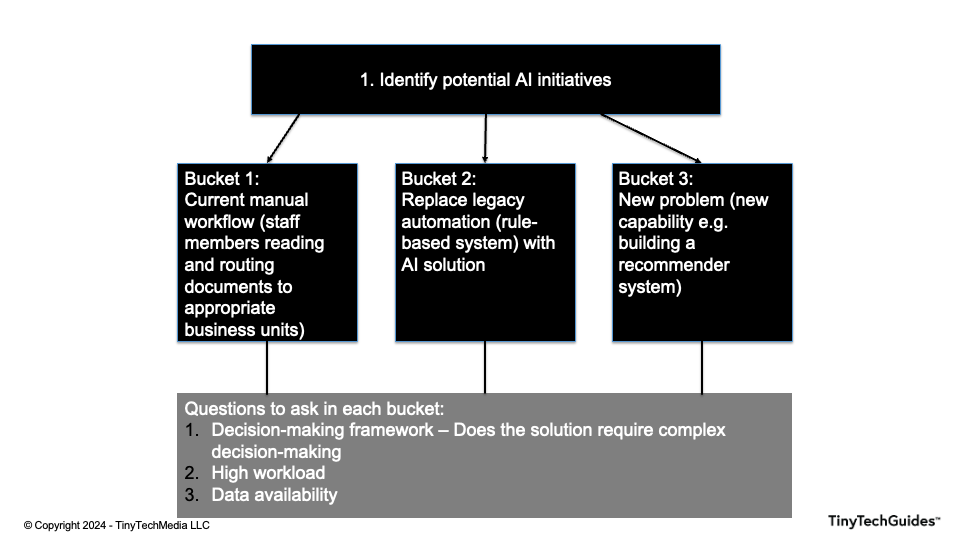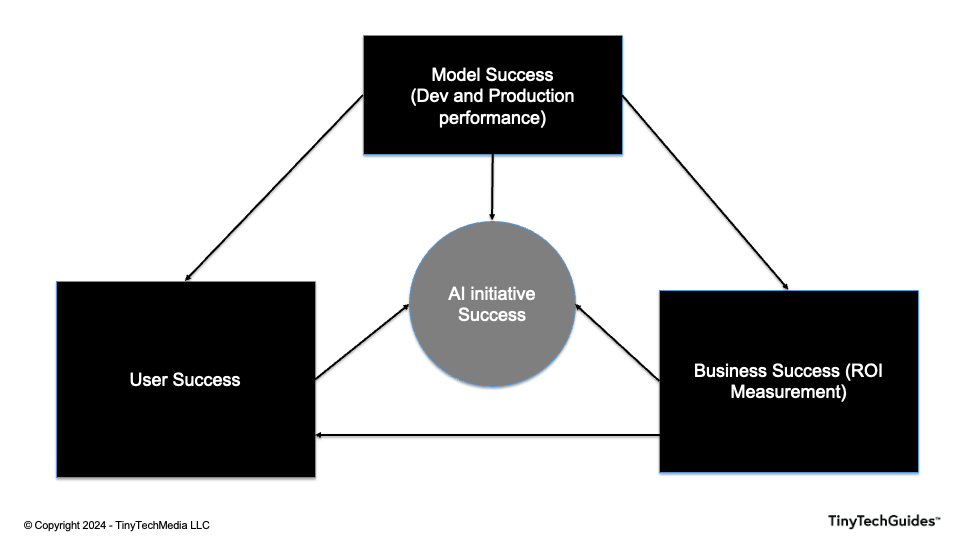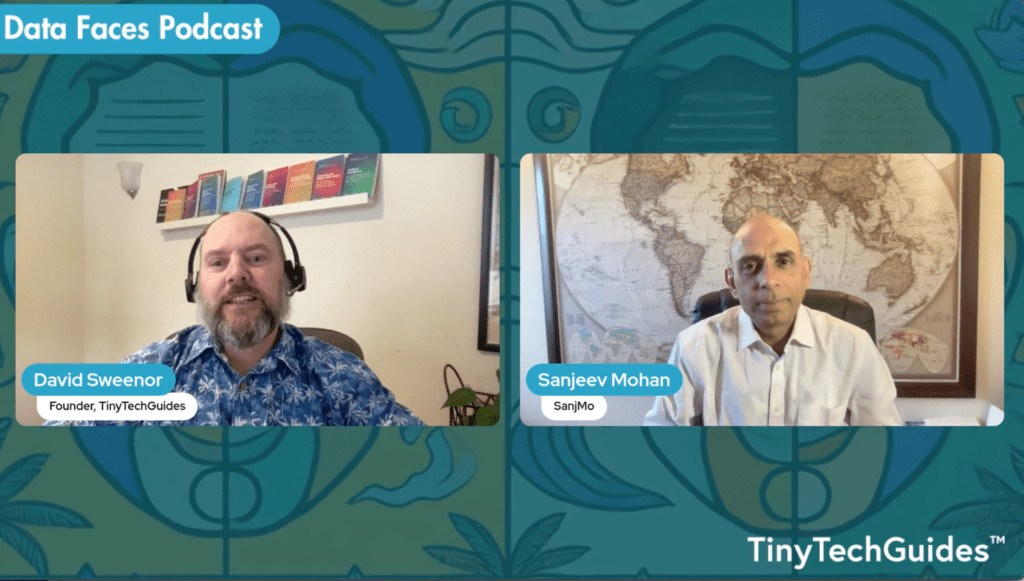
Introduction
The race to implement generative AI is no longer an option for enterprises—it’s an imperative. Companies delaying AI adoption risk losing ground. As businesses rush to integrate generative AI into their operations, the path to successful implementation is far from straightforward. Moving beyond initial experiments and proof of concepts (POCs) demands thorough planning and coordination between business and IT leaders. A solid business case is not a mere formality; it is essential to steer clear of poorly executed initiatives and ensure that AI investments deliver business value.
Did you know that only 11% of organizations manage to scale AI initiatives from prototypes to enterprise-grade systems?[1] This statistic highlights the need for a structured approach, ensuring generative AI projects align with an organization’s overall strategy, financial capabilities, and technological preparedness.
A more thorough treatment of this can be found in our latest TinyTechGuide.
Establish Guiding Principles for AI Projects
Generative AI offers substantial potential across various business functions, but not every opportunity is worth pursuing. Your first step as a business leader is to establish clear guiding principles that will shape your AI initiatives. Without a strong foundation, organizations risk chasing low-value projects or, worse, deploying AI in areas where the risks outweigh the benefits.
Key questions to answer before moving forward:
- What level of risk is your company prepared to take? In industries like healthcare or finance, regulatory constraints can severely limit where AI can be applied. Understanding where these boundaries lie is crucial.
- Are there legal or safety-related areas where generative AI could be restricted or harmful, such as automated claims processing or patient care?
- How fast are your competitors moving, and does that pose a threat? Organizations that fail to keep pace risk being outmaneuvered.
- Is your organization technologically mature enough to implement AI? Evaluate your current infrastructure and whether your workforce has the necessary skills to handle AI deployment.
- Is there a budget for AI systems, or can funding be secured to ensure the projects can scale?
Generative AI isn’t a one-size-fits-all solution. You must set criteria that prioritize projects based on risk, competitive dynamics, and financial and technological readiness.
Identifying High-Impact AI Opportunities
Inaction could mean falling behind as competitors use AI to drive efficiencies and uncover new revenue streams. To find the highest-impact opportunities, look at your existing processes in three key categories:
- Manual workflows: These are ideal candidates for automation, where AI can reduce time and errors significantly.
- Legacy systems: Many organizations still rely on rigid, rule-based systems that AI can replace with more adaptive and scalable solutions.
- New growth areas: Explore opportunities where AI can create and unlock new products, services, or markets.
Frame each opportunity by asking these four critical questions:
- Does this solution require complex decision-making that AI can enhance?
- Is there a high volume of tasks in the current process that AI could streamline?
- Is the necessary data available, clean, and structured for AI?
- Can you quantify the time savings and other tangible benefits AI would deliver?

Answering these questions will help your organization identify where AI can make the most immediate impact, maximizing returns in the shortest time.
Prioritize Use Cases with a Decision Matrix
Once you’ve identified potential opportunities, the next step is to prioritize them. You can’t do everything at once. Spreading resources too thin will dilute results and slow progress. A decision matrix can help you focus on high-value opportunities while avoiding common pitfalls like pursuing projects with low impact or high complexity.
Several frameworks can guide prioritization:
- 2×2 matrix comparing business value vs. ease of implementation: This approach highlights the highest-value, easiest-to-implement projects.
- 2×2 matrix of demand vs. risk: This framework helps balance projects that offer high demand but may also come with significant risks.
- WINS framework: Focuses on identifying projects that deliver quick wins with minimal risk[2].
Here’s an example of how a decision matrix can be used:
| Decision Criteria / Applications | Use Case A | Use Case B | Use Case C | Weight (%) |
|————————-|————-|————|————|————|
| Value Impact | 8 | 6 | 7 | 20% |
| Strategic Alignment | 7 | 8 | 6 | 15% |
| Technical Feasibility | 6 | 7 | 8 | 15% |
| Operational Feasibility | 5 | 6 | 7 | 10% |
| ROI Estimation | 9 | 7 | 6 | 20% |
| Risk Assessment | 7 | 8 | 6 | 10% |
| Market Readiness | 6 | 7 | 8 | 5% |
| Scalability | 7 | 5 | 6 | 5% |
| Total Score | 6.9 | 6.8 | 6.7 | 100% |
This matrix assigns weights based on business needs and helps clarify which AI projects to prioritize for the best short- and long-term returns.
Once priorities are set, it’s essential to avoid getting stuck in analysis paralysis. While thorough evaluation is important, competitors are moving quickly, and you need to act before valuable opportunities are lost.
Building the Business Case: Balancing Stakeholder Priorities
Successfully implementing AI requires balancing the priorities of three primary forces: business, finance, and IT. Each group has its own objectives, and without clear alignment, your AI initiatives will either stall or fail.
- The business side is eager for quick wins that enhance customer interactions or improve operational efficiency.
- Finance demands clear, measurable ROI. They control the purse strings and need assurance that any AI project will provide fast, quantifiable returns.
- IT is tasked with protecting infrastructure, ensuring data security, and managing the risk of AI deployment. They often move more cautiously than the other groups.
Without alignment, AI projects are prone to delays, with business pushing too fast and IT moving too slowly. To overcome this, develop a value map that identifies two or three quick wins that deliver fast ROI and one or two longer-term initiatives that may require more foundational investment. A clear value map keeps all stakeholders aligned and ensures that both short-term gains and long-term strategies are accounted for.
Estimating Costs for Generative AI Initiatives
Generative AI projects come with significant costs, but the real question is: What’s the cost of doing nothing?
Key cost drivers include:
- Model size and complexity: Larger, more complex models are computationally expensive but can provide more sophisticated insights.
- Token usage and API calls: Every interaction with an AI model incurs costs based on the number of tokens processed (a token can be a word or part of a word).
- Fine-tuning models: Customizing a model with industry-specific or proprietary data increases costs.
- RAG deployment: Using retrieval-augmented generation (RAG) models can add costs for vector databases and storage.
For example, a project using 30,000 tokens (15,000 input tokens and 15,000 output tokens) could cost approximately $1 per 1,000 tokens, depending on the model. Multiply this by the number of API calls and the complexity of the model to estimate your total project costs. It’s essential to understand these factors upfront to prevent budget overruns.
While costs may seem high, companies that act now will benefit from reduced operational inefficiencies and greater market adaptability in the long term.
Calculating ROI and Demonstrating Success
Calculating ROI for generative AI initiatives is crucial for securing long-term investment. Boards and stakeholders need to see clear financial benefits, and it’s your responsibility to deliver them.
Measuring success involves three key areas:
- Model performance: Does the AI system perform consistently and deliver accurate, reliable results?
- User adoption: Are employees and customers finding the AI helpful? Poor user experience can undermine even the best AI technology.
- Business outcomes: Are the financial returns there? Have you saved time, reduced costs, or created new revenue streams?

Consider the following ROI example from a generative AI project:
- Year 1: Initial setup and infrastructure costs lead to a negative ROI of -50.55%, reflecting upfront investments.
- Year 3: As AI systems mature, time savings and operational efficiencies yield a positive ROI of up to 286.71%.
The longer-term ROI is often much greater than initial costs, and quick wins using publicly available AI services can deliver early, visible returns.
Conclusion
Generative AI is already transforming industries, and the window of opportunity to lead is closing. Waiting for the perfect moment or delaying for more data will only set your business back as competitors forge ahead. The companies that act now—building a strong business case and aligning stakeholders—will shape the future.
The window to become a market leader in AI is closing rapidly. By acting now and building a clear, actionable business case, your company can secure a competitive edge that will be hard to replicate later. Time is running out, and those that seize AI opportunities today will be the ones defining tomorrow.
If you enjoyed this article, please sign up for my newsletter. Consider following me on Medium and LinkedIn.
Please consider supporting TinyTechGuides by purchasing any of the following books.
● The Generative AI Practitioner’s Guide: LLM Patterns for Enterprise Applications
● Generative AI Business Applications: An Exec Guide with Life Examples and Case Studies
● Artificial Intelligence: An Executive Guide to Make AI Work for Your Business
● The CIO’s Guide to Adopting Generative AI: Five Keys to Success
● Mastering the Modern Data Stack
● Modern B2B Marketing: A Practioner’s Guide for Marketing Excellence
[1] Baig, Aamer, Douglas Merrill, Megha Sinha, Danesha Mead, and Stephen Xu. 2024. “How CIOs Can Scale Gen AI | McKinsey.” Www.mckinsey.com. May 13, 2024. https://www.mckinsey.com/capabilities/mckinsey-digital/our-insights/moving-past-gen-ais-honeymoon-phase-seven-hard-truths-for-cios-to-get-from-pilot-to-scale.
[2] Baier, Paul, Jimmy Hexter, and John J. Sviokla. 2023. “Where Should Your Company Start with GenAI?” Harvard Business Review. September 11, 2023. https://hbr.org/2023/09/where-should-your-company-start-with-genai.



